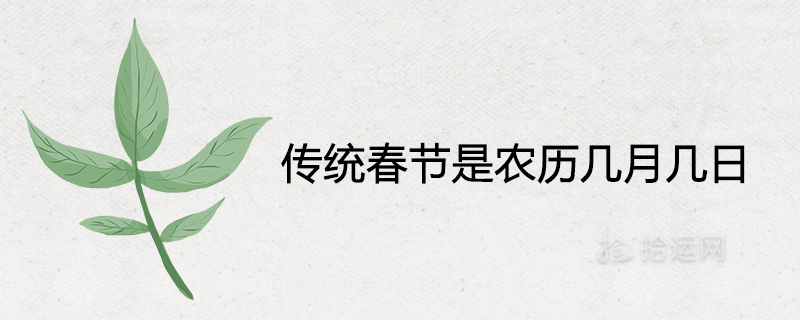The traditional Spring Festival is the lunar month and a few days. What is the historical origin?
The Spring Festival originated from people’s sacrifices for the beginning of the year and the beginning of spring.It must be the Spring Festival, so the specific time of the traditional Spring Festival refers to the first day of the first lunar month.

The origin of the Spring Festival
In the early era of visual observation and timing, the age was determined according to the shifting of the stars."The bucket handle returns to Yin", the earth rejuvenates, the end comes back to the beginning, everything is renewed, and a new reincarnation begins.In the traditional farming society, the beginning of the Spring Festival is of great significance, and a large number of folk cultures related to the Spring Festival have been derived.In the historical development, although the calendars used are different and the dates of the New Year’s Day festivals are different, the festival framework and many folk customs have been inherited.Headed by the Hundred Festival Year, the Spring Festival is the most solemn traditional festival of the Chinese nation.
The "first day of the first month" in the current lunar calendar is historically known as Yuanshuo, Yuanri, Xinyuan, New Year’s Day, Zhengri, Yuanchen, Xinzheng, etc.The name of the "Spring Festival" on the first day of the first month of the lunar calendar now does not exist in ancient times (generally called New Year’s Day and New Year’s Festival in ancient times), but was created by the government of the Republic of China.The concept of "Spring Festival" was gradually brought up in the period of the Republic of China.During the Republic of China, the Gregorian calendar was introduced, and the lunar calendar became the standard for farming.In 1914, the government of the Republic of China mentioned in the report of the Ministry of Internal Affairs that "the New Year’s Day of the lunar calendar is proposed to be the Spring Festival".Therefore, the saying of the Spring Festival has gradually spread.
After the Revolution of 1911, the Gregorian calendar was adopted during the Beiyang government of the Republic of China in 1912, but the "Republic of China" was used as the year, and January 1 was the beginning of the Gregorian calendar; 1) As "Spring Festival", it is regarded as the beginning of the Lunar New Year, that is, the beginning of the year.On September 27, 1949, the first plenary session of the Chinese People’s Political Consultative Conference decided to adopt the "AD chronology method", calling January 1 of the Gregorian calendar "New Year’s Day", and the first day of the first month of the Chinese calendar as "Spring Festival".
The time of the Spring Festival
Ancient times:Sui Ji She Ti, that is, the method of stem and branch era.The handle of the Big Dipper starts from due east by north (the Houtian Bagua Gen position), and rotates clockwise once, which is called one year old (photographing).Dou refers to Yin as Chunzheng (first month), the month of "Jianzheng" is Yin month, and the beginning of spring is the beginning of the year.(Astral calendar)
Xia, Shang and Zhou:The first month of the Xia calendar is in Mengchun, the first month of the Shang calendar is in December in winter, and the first month of the Zhou calendar is in November in winter.(Lunar calendar)
After Qin Shihuang unified the six kingdoms, the Qin calendar (Zuanxu calendar) was used, and the first month was in October in winter.(Lunar calendar)
The Qin calendar (Zuanxu calendar) was used in the early Han Dynasty.In the first year of Emperor Wu of the Han Dynasty, that is, in 104 BC, astronomers Tang Du, Luoxiahong, Deng Ping and others formulated the "Taichu Calendar" (also known as the "Eighty-one Divided Law Calendar"), and absorbed the solar terms of the Ganzhi Calendar.The ingredients are used as a calendar supplement to guide farming, and the first day of the year is changed from October 1st in winter to January 1st in spring.
After the Han Dynasty, several emperors had changed the calendar and the beginning of the year.After Wang Mang usurped the Han Dynasty, he stipulated that the first day of the twelfth lunar month was the beginning of the year, which was Yin Zheng.Cao Rui, Emperor Wei Ming, was also changed to Yin Zheng for a time.After Wu Zetian proclaimed emperor, he changed the country name to "Zhou" and adopted Zhou Zheng.Since then, successive dynasties have switched to Xiazheng, with the first day of the first month as the beginning of the year.(Note:Wu Zetian ascended the throne on the ninth day of September in 690.In that year, there were two "first days of the first lunar month":February 15 in 690 and December 6 in 690.)
After generations of development, later generations gradually perfected the Chinese calendar on the basis of the early calendar.Since then, China has been using the Chinese calendar until now.After 1970, "Xia Li" was renamed "Lunar Calendar" (yin-yang calendar).
After the Revolution of 1911, the Gregorian calendar (a type of solar calendar, also known as the Gregorian calendar) was gradually used.Later, in order to distinguish the two New Years from the Chinese calendar and the Gregorian calendar, since the first day of the first month of the summer calendar is just before and after the "Li Chun" solar term, one of the twenty-four specific seasons that represent seasonal changes in the Ganzhi calendar, the first day of the first month of the first month of the Chinese calendar (lunar calendar) was used.It was renamed "Spring Festival", and the 1st month of the Gregorian calendar was renamed "New Year’s Day".
In July 1913 (the second year of the Republic of China), Yuan Shikai approved the first day of the first lunar month as the Spring Festival, and agreed that the Spring Festival would be a regular holiday, which began in 1914.Since then, the beginning of the Lunar New Year has been changed from the previous "New Year" to "Spring Festival".

微信扫码关注
更新实时通知
